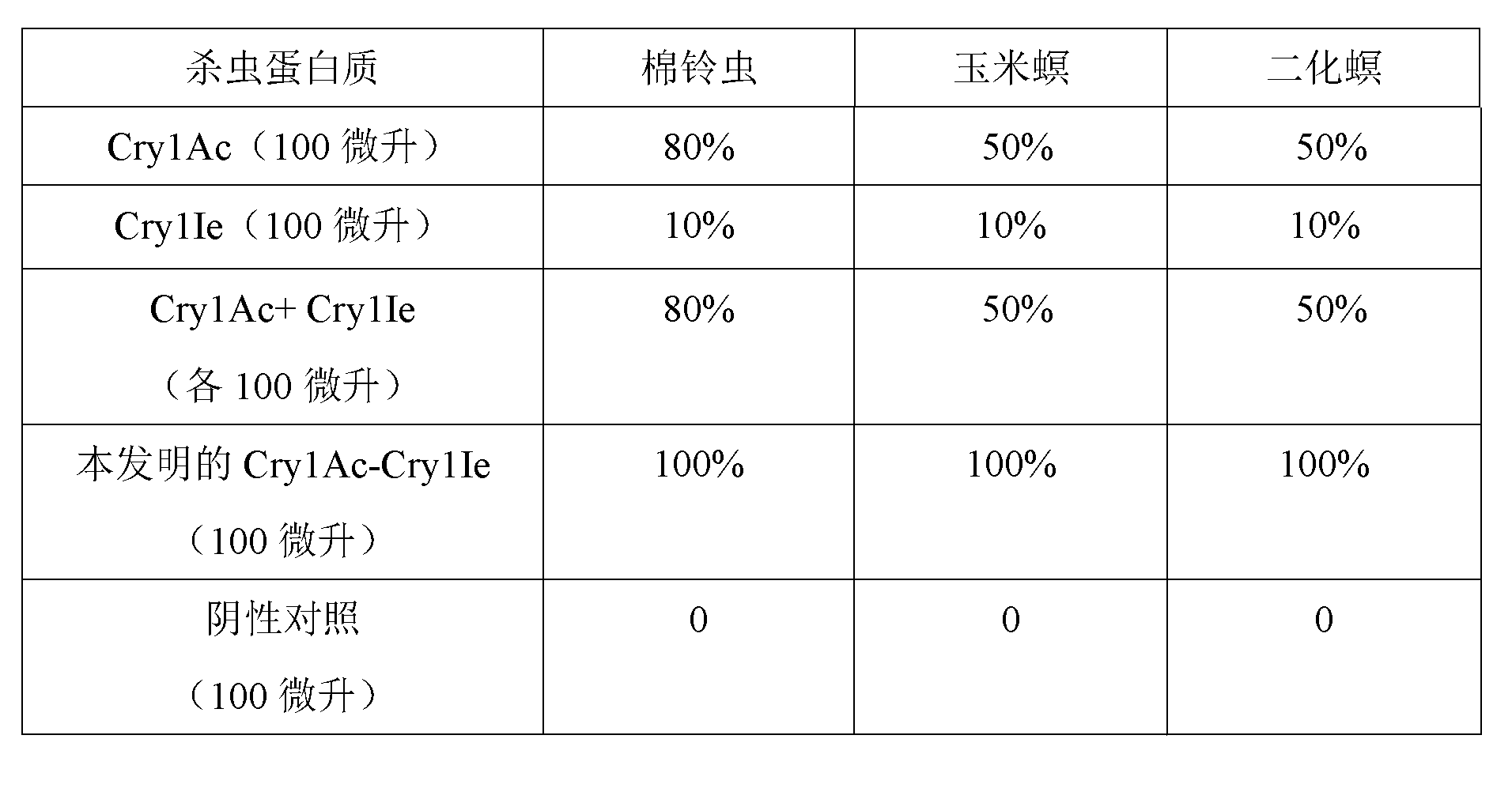Insect-resistant fusion gene as well as insect-resistant fusion protein and application of insect-resistant fusion gene and insect-resistant fusion protein
A fusion gene and fusion protein technology, applied in the field of plant genetic engineering, can solve problems such as low insecticidal activity, narrow insecticidal spectrum, and insecticidal protein pest resistance, and achieve broad insecticidal spectrum, improved insecticidal activity, and slow down The effect of pest resistance
- Summary
- Abstract
- Description
- Claims
- Application Information
AI Technical Summary
Problems solved by technology
Method used
Image
Examples
Embodiment 1
[0025] Embodiment 1, construction of cry1Ac-cry1Ie fusion gene:
[0026] The genes encoding Cry1Ac and Cry1Ie insecticidal proteins were commissioned by Shanghai Sangong to synthesize, and their DNA sequences are SEQ ID NO: 4 and SEQ ID NO: 6, respectively. The cry1Ac gene was cloned between the sites of restriction enzymes BamHI and SacI in the vector pET28a expression vector, and the resulting vector was named pET-1Ac, which encoded a protein whose amino acid sequence was SEQ ID NO: 3; the cry1Ie gene was Cloned into the vector pET28a expression vector between the sites of restriction enzymes BamHI and SacI, the obtained vector was named pET-1Ie, which encoded a protein whose amino acid sequence was SEQ ID NO:5.
[0027] Construction process of pET-1Ac-1Ie: the cry1Ac fragment was obtained by digesting pET-1Ac with BamHI and XmaI, and the cry1Ie fragment was obtained by digesting pET-1Ie with XmaI and SacI. The vector pET28a was digested with BamHI and SacI and ligated with...
Embodiment 2
[0028] Embodiment 2, the preparation of insecticidal protein:
[0029] Vectors pET-1Ac, pET-1Ie and pET-1Ac-1Ie containing insecticidal genes were respectively introduced into BL21 Star (E.coli) cell line, and single clones were selected on LB solid medium containing 50 mg / L kanamycin. Inoculate a single colony into 100 ml of LB bacterial culture medium, shake culture at 37°C to OD 600 =0.6, then add IPTG (Isopropyl-β-D-thiogalactoside) to a concentration of 0.5mM, and continue culturing under the same conditions for 4 hours. The culture solution was centrifuged at 5000 g for 10 minutes to pellet E. coli cells, and then the supernatant was discarded to collect the pellet. Add 30 ml of 20 mM Tris-HCl buffer solution to the precipitate, and ultrasonically crush it. The recombinant protein thus obtained was used for the determination of insecticidal activity.
Embodiment 3
[0030] Embodiment 3, the insecticidal activity assay of the insecticidal protein expressed in Escherichia coli:
[0031] 100 microliters of the insecticidal proteins obtained in Example 2 were applied alone or mixed on the surface of 0.5 square centimeters of insect artificial feed, and fed to newborn first-instar larvae for insecticidal activity determination. The preparation method of the negative control was similar to Example 2, but the plasmid was the pET28a vector itself without any inserted DNA. After raising for 7 days, the insecticidal rate was counted, and the results are shown in Tables 1 and 2:
[0032] Table 1. Insecticidal rate of Cry1Ac-Cry1I
[0033]
[0034] The results showed that the insecticidal activity of the fusion protein Cry1Ac-Cry1I was significantly higher than that of Cry1Ac or Cry1I alone, and also significantly higher than that of the mixture of Cry1Ac and Cry1I.
PUM
 Login to View More
Login to View More Abstract
Description
Claims
Application Information
 Login to View More
Login to View More - R&D
- Intellectual Property
- Life Sciences
- Materials
- Tech Scout
- Unparalleled Data Quality
- Higher Quality Content
- 60% Fewer Hallucinations
Browse by: Latest US Patents, China's latest patents, Technical Efficacy Thesaurus, Application Domain, Technology Topic, Popular Technical Reports.
© 2025 PatSnap. All rights reserved.Legal|Privacy policy|Modern Slavery Act Transparency Statement|Sitemap|About US| Contact US: help@patsnap.com



